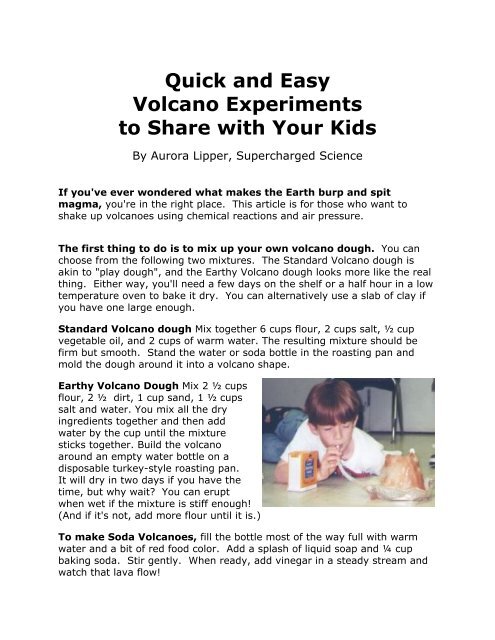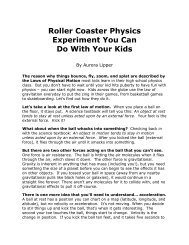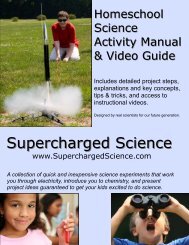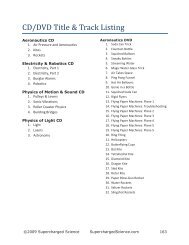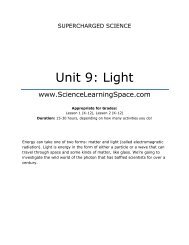Quick and Easy Volcano Experiments to Share with Your Kids
Quick and Easy Volcano Experiments to Share with Your Kids
Quick and Easy Volcano Experiments to Share with Your Kids
Create successful ePaper yourself
Turn your PDF publications into a flip-book with our unique Google optimized e-Paper software.
<strong>Quick</strong> <strong>and</strong> <strong>Easy</strong><br />
<strong>Volcano</strong> <strong>Experiments</strong><br />
<strong>to</strong> <strong>Share</strong> <strong>with</strong> <strong>Your</strong> <strong>Kids</strong><br />
By Aurora Lipper, Supercharged Science<br />
If you've ever wondered what makes the Earth burp <strong>and</strong> spit<br />
magma, you're in the right place. This article is for those who want <strong>to</strong><br />
shake up volcanoes using chemical reactions <strong>and</strong> air pressure.<br />
The first thing <strong>to</strong> do is <strong>to</strong> mix up your own volcano dough. You can<br />
choose from the following two mixtures. The St<strong>and</strong>ard <strong>Volcano</strong> dough is<br />
akin <strong>to</strong> "play dough", <strong>and</strong> the Earthy <strong>Volcano</strong> dough looks more like the real<br />
thing. Either way, you'll need a few days on the shelf or a half hour in a low<br />
temperature oven <strong>to</strong> bake it dry. You can alternatively use a slab of clay if<br />
you have one large enough.<br />
St<strong>and</strong>ard <strong>Volcano</strong> dough Mix <strong>to</strong>gether 6 cups flour, 2 cups salt, ½ cup<br />
vegetable oil, <strong>and</strong> 2 cups of warm water. The resulting mixture should be<br />
firm but smooth. St<strong>and</strong> the water or soda bottle in the roasting pan <strong>and</strong><br />
mold the dough around it in<strong>to</strong> a volcano shape.<br />
Earthy <strong>Volcano</strong> Dough Mix 2 ½ cups<br />
flour, 2 ½ dirt, 1 cup s<strong>and</strong>, 1 ½ cups<br />
salt <strong>and</strong> water. You mix all the dry<br />
ingredients <strong>to</strong>gether <strong>and</strong> then add<br />
water by the cup until the mixture<br />
sticks <strong>to</strong>gether. Build the volcano<br />
around an empty water bottle on a<br />
disposable turkey-style roasting pan.<br />
It will dry in two days if you have the<br />
time, but why wait? You can erupt<br />
when wet if the mixture is stiff enough!<br />
(And if it's not, add more flour until it is.)<br />
To make Soda <strong>Volcano</strong>es, fill the bottle most of the way full <strong>with</strong> warm<br />
water <strong>and</strong> a bit of red food color. Add a splash of liquid soap <strong>and</strong> ¼ cup<br />
baking soda. Stir gently. When ready, add vinegar in a steady stream <strong>and</strong><br />
watch that lava flow!
Building Air Pressure Sulfur <strong>Volcano</strong>es takes a bit more work. Wrap<br />
the dough around the tubing in<strong>to</strong> an ice-cream-cone-shape <strong>and</strong> slap the icecream-end<br />
down in<strong>to</strong> your roasting pan tray. Push <strong>and</strong> pull the tube from<br />
the bot<strong>to</strong>m until the other end of the tube is just below the volcano tip.<br />
Using your fingers, shape the inside <strong>to</strong>p of the volcano <strong>to</strong> resemble a<br />
small Dixie cup. <strong>Your</strong> solution needs a chamber <strong>to</strong> mix <strong>and</strong> grow in before<br />
overflowing down the mountain. The tube goes at the bot<strong>to</strong>m of the claycup<br />
space. Be sure the volcano is SEALED <strong>to</strong> the cookie sheet at the bot<strong>to</strong>m.<br />
You won’t want the solution running out of the bot<strong>to</strong>m of the volcano instead<br />
of popping up out the <strong>to</strong>p!<br />
Make your chemical reactants.<br />
Solution 1: In one bucket, fill halfway <strong>with</strong> warm water <strong>and</strong> add one<br />
<strong>to</strong> two cups baking soda. Add one cup of liquid dish soap <strong>and</strong> stir very<br />
gently so you don’t make <strong>to</strong>o many bubbles.<br />
Solution 2: In a different bucket, fill halfway <strong>with</strong> water <strong>and</strong> place one<br />
cup of aluminum sulfate (find this at the gardening section of the<br />
hardware s<strong>to</strong>re). Add red food coloring <strong>and</strong> stir.<br />
Putting it all <strong>to</strong>gether: Practice your breathing: count ONE (<strong>and</strong> pour in<br />
Solution 1), TWO (inhale air only!), <strong>and</strong> THREE (pour in Solution 2 as you<br />
put your lips <strong>to</strong> the tube <strong>and</strong> puff as hard as you can!). Lava should not only<br />
flow but burp <strong>and</strong> spit all over the place!<br />
__________________________________________________________<br />
Since 1996, Aurora Lipper has been helping families learn science. As a<br />
pilot, astronomer, mechanical engineer <strong>and</strong> university instruc<strong>to</strong>r, Aurora can<br />
transform <strong>to</strong>ilet paper tubes in<strong>to</strong> real working radios <strong>and</strong> make laser light<br />
shows from Tupperware.<br />
If you enjoyed this experiment <strong>and</strong> want more, jump online <strong>to</strong> get your free<br />
copy of the Science Workbook at:<br />
www.SuperchargedScience.com


